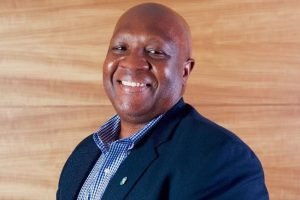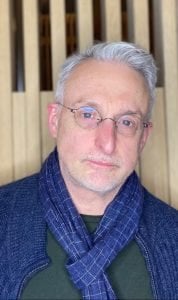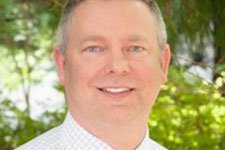MedShare has delivered over $220 million in medical aid to communities in 103 countries and combined with Phillips’ state of the art biomedical equipment, is improving the quality of biomedical service offerings in underserved communities around the world.
The following transcript has been lightly edited and condensed for ease of reading.
David Kirkpatrick: So, this next session is also very much focused on collaboration for responsible growth, both on the collaboration and the responsibility side. So maybe you should move your chair slightly up, Rob. Thank you. So I can see you. Rob Stevens, on my left and your right, is a general manager at Philips, and he is very involved in a partnership that Philips has with Charles Redding’s organization, MedShare, which he is the CEO of after having spent many years at Johnson & Johnson in logistics and other stuff in senior roles. And MedShare—well, I have this statistic right here—has delivered over $220 million in medical aid to communities in 103 countries, and is partnering with Philips, with their state-of-the-art biomedical equipment, in order to improve biomedical service offerings in underserved communities around the world. And really just taking a very big picture view of how we can responsibly assist people in the world who have less, but also be more sustainable in the use of what we’ve got here, because otherwise, a lot of it would get thrown out. I mean, Charles, talk a little bit about what—how to think about it. Am I saying it right?
Charles Redding: No, I mean, you are. I mean, the core principle of our mission is to take things that normally would end up perhaps in landfill, just because they’ve outlived their usefulness here in the U.S., and at the same time, repurpose these things to save lives. And so if you think about it, particularly in the developing countries, sub-Saharan Africa, upwards of 70%, 70% of the equipment is unused, inoperable. And it’s typically because either they don’t have the instruction manuals, they don’t know how to use it. And partnerships like we have will bring a sustainability factor to these communities that can repair this equipment and ensure that it’s continuing to deliver healthy outcomes for the patients.
Kirkpatrick: And you partner, I know, with many, many companies. Philips, though, I think is one of your biggest partners. Maybe, Rob, you should just quickly describe what Philips does, because it’s changed in recent years a little bit. It’s really honed in on the medical. Explain that, and then talk about how you think about partnering with MedShare.
Rob Stevens: Sure. So maybe many of you recognize Philips as a television or a lightbulb company, but really, we’ve transformed the organization into a pure health technology, where we’re focused on a continuum of healthcare, starting with prevention. And then when you go into a hospital or healthcare facility, but then also living with chronic disease or taking better care of yourself at home. And that’s really the mission of Philips, is to improve the lives of three billion people by the year 2030.
Kirkpatrick: That’s a target you have, right. But in terms of technology, you’re very big in certain technology areas. Just talk about what some of them are.
Stevens: So, MRI, CT, monitoring, in terms of biomedical equipment. But also extending beyond that with healthy living, such as Sonicare toothbrush, but also our mother and child, through the Avent baby products as well. And then a full line of monitoring fetal equipment, incubators, as well.
Kirkpatrick: So give some examples of the kinds of things that you would be able to provide to MedShare, and then maybe Charles can talk about what MedShare does with that.
Stevens: Sure. So we donate—as an example—ultrasound, fetal monitors, and then of course as I mentioned before, the Avent baby care product line, and that’s really in support of MedShare’s mother and child wellness program. But for Philips, and for me, what makes this relationship unique and one that works so well, is that we just don’t donate the equipment. My team is providing all the manuals, service manuals, operation manuals, service training, as well as clinical application. So we’re ensuring that that product is going to meet its intended purpose and continue to live another useful life once it leaves the United States.
Kirkpatrick: And just one more thing, Philips, unlike a lot of American companies—Philips is American, but it’s headquartered in the Netherlands.
Stevens: Yep.
Kirkpatrick: You really talk about the circular economy, which is something that I think we need to talk more about, because what would happen to this stuff otherwise, a lot of it? Where do you get it? Just quickly.
Stevens: Yeah, so where we get most of it is either through our demo fleet, as well as—the majority comes in through traded-in equipment. So, you know, a customer in the United States just bought a new piece of equipment, and it comes back to our Nashville services facility. And that’s both Philips and non-Philips equipment. And just to give a statistic, last year we recovered more than two million pounds from the returned equipment—either the steel, breaking it down to its raw material, steel, copper, etcetera. For a subset of the products that we ensure are fully functional, we have all the information, all the documentation, that’s where it enters the pipeline into the MedShare organization for, again, a second life, if you will.
Kirkpatrick: Yeah. So, Charles, where would it go, for example?
Redding: Yeah, I mean, one of the programs you mentioned was our maternal-child health program, and the ultrasounds are literally a godsend for us. Probably the best way really is just to share a story, particularly—most of the countries we’re working with, many times have no ultrasounds, let alone one or two or three. So even if they have one, if we provide them with another one, we’ve increased their capacity, we’ve doubled their capacity. But we had a situation recently in Nicaragua where we delivered an ultrasound to where a mother was actually in distress. And using the ultrasound, they were able to determine that the baby was in distress, was the reason it was causing distress for the mother. She was very low on the amniotic fluid. They conducted an emergency C-section and saved both the mother and the child. And so without equipment like this, they just can’t do the diagnosis they need to improve the outcomes for the patients.
We hear these stories all the time. Most of our work, we try to help them make progress toward the sustainability development goal, particularly in the way of good health, and the way we go about doing it is really just to help them improve the quality of their health system, to improve access to quality healthcare. And it’s through partnerships, what we can bring in is cutting-edge technology to really lift the results of that entire community, is where I have hope that we can improve the state of the world.
Kirkpatrick: One thing I didn’t ask you about when we talked on the phone was how much global experience you had before doing this. But as an American, we complain about our healthcare system, but we got an awful lot going on compared to—I mean, how shocked have you been as you’ve been to travel around the world more methodically to some of these countries that really have so little? Just talk a little bit about your feelings about that.
Redding: Yeah, one of the first questions I often get is, why are you guys focused so much outside the U.S.? And although we do provide services inside the U.S. as well, to the underinsured and uninsured, the best way to describe it to anyone that asks me that question is simple: on your worst day here in the U.S., you have an option of going into a hospital, right? In many of the countries that we work with, there is no hospital to go into. Or if there is one, maybe it’s 50, 60 miles away. Many of these countries, the only source of healthcare is through what we call primary care. And that could be through a health post, some community-based service, very low-tech. And so most of our products and services, we focus not just on the high-tech solutions, but also on those very low-tech—something as simple as a clean birthing kit for a mother that’s going to give birth outside of the medical institution could mean lifesaving, both for the mother and the child. And this is just very something—to cover the ground and make sure they’re using clean items to reduce the infections, to make sure you can have a healthy baby.
So it’s just—it’s really no comparison. I’d be the first to admit that we’ve got issues here that need to continue to work on, but as I’ve traveled around the globe, I’ve just been—you know, my heart hurts when I see some of the conditions, and knowing that we are throwing things away here that can literally save lives there. And that’s why I’m so passionate about the work we do.
Kirkpatrick: Well, and it is true, the sustainable goals are uncompromising in what we’re trying to achieve as this planet by 2030, which is really, give healthcare services to everyone.
Redding: Yes.
Kirkpatrick: No poverty is one of the goals. That is not a joke. That’s a hard thing to achieve, but it’s a reasonable target to have. So—but I wonder whether either one of you can talk about, you know, having worked together, maybe you’ve gotten some thoughts about other ways that we can move in comparable partnering directions. Obviously, this is a very powerful program, but it’s relatively small compared to the scope of need, and probably the scope of opportunity. Any thoughts from either one of you on that?
Redding: Yeah, no, I’m a true believer in these public-private partnerships. It’s really—in most of the work, it’s really the public partnered with private institutions and the governments. And part of the work has to be focused on helping them help themselves. So not going in with a perceived solution, but understanding what the challenge is, and bringing people with various resources together. So I just think that’s a scalable model. Most of the issues we find in the world, if there’s a collaborative effort—in fact, we’ve even changed a lot of our impact metrics around collaborative impact, as opposed to assuming you can do it alone. If we want to make true progress and do it in a very rapid pace, the only way to do it is to collaborate. Which is why I’m so thankful of the partnerships I have with Philips and other large healthcare companies like that.
Kirkpatrick: Any thoughts, other things you are doing or could do or want to do?
Stevens: Well, there’s a lot of things that we want to do and that we could do, and Charles and I were talking about those this morning before we stepped in here. But I think—I just want to reiterate one point, which is, you have to help the local organizations be able to sustain themselves. And that’s why Philips has taken the approach not just to donate the equipment, but to ensure that through our partnership with MedShare and the train the trainer model, that the local teams in the local countries know how to service the product, know how to use the product to its full capability. Because if it was just, here’s the machine, it’s a sub-optimized proposition.
Kirkpatrick: Yeah, it’s not just about us feeling good about giving something away, it’s about making sure it really makes a difference.
Stevens: That’s right.
Redding: That’s right.
Kirkpatrick: Well, what were you talking about that you could do that you haven’t done yet?
Stevens: [LAUGHS]
Redding: [LAUGHS] So, I’m always thinking up these ideas, but one of the things we want to do—we understand the importance of biomed training and repair, and we have one engineer that literally spends the bulk of his time going to these different countries, doing pre-assessments, bringing and calling in 30, 35 technicians, end users, electricians, just to train them how to properly repair and giving them the tools. And one of the things that we were just talking about—why not open that up to others? There’s a lot of trained biomed professionals here. So we’d like to start these biomed mission trips, where we put a call out to go to a particular country, a particular hospital, and we—come travel with us and maximize our impact.
Kirkpatrick: Right, and we didn’t talk about the volunteerism where Philips is putting a lot of people hours into this too. Talk about that a little bit.
Stevens: So I’m also a volunteer at MedShare as well. And so I’ve gotten to firsthand experience their unique process. So, in the warehouse, taking pallets of surplus materials that have been provided, donated from hospitals, and through an innovative process, collect, categorize, organize, repackage, so that those goods can then be put into MedShare’s warehouse and inventory so that those goods can serve people and save lives.
Kirkpatrick: And the company encourages—I know there’s a huge amount of volunteerism that Philips—do you have the figure of how many hours or how many people? It’s a lot of people.
Stevens: We’ve been partnering and volunteering with MedShare for over seven years, and so it’s measured in thousands of hours.
Redding: It’s huge.
Kirkpatrick: Well, actually, you have these—what, how many giant warehouses?
Redding: Well, we’ve got three, and we use 20,000 volunteers a year.
Kirkpatrick: And these warehouses are packed, because it’s not just ultrasound and CT scans, it’s also gowns and bandages and all kinds of things.
Redding: That’s correct. Dressings, sutures, shoe covers.
Kirkpatrick: Well, I hope it grows even bigger. I hope more companies are inspired to do something similar. And thank you both for coming here to explain it.
Redding: Thank you.
Stevens: Thank you.
Redding: Thank you very much.
[APPLAUSE]





